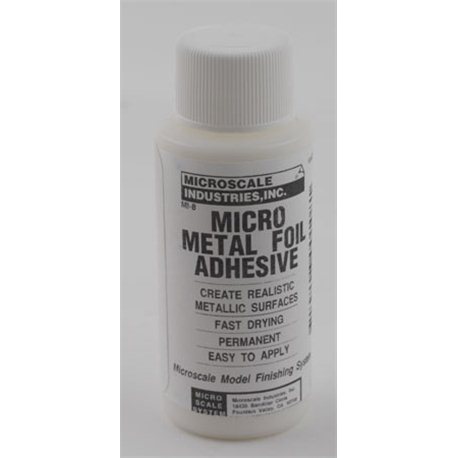No products
Micro Metal Foil Adhesive
MSMFA
New product
Micro Metal Foil Adhesive
1 oz. bottle
Very easy and very inexpensive way to apply real metal foil to your models. The most common foil is ordinary household Aluminum foil, which most people have in their homes. With a little checking around you will find that there is also stainless steel foil, copper foil and a few others. The softer and thinner foils are the easiest to use, but if the surface you want to metal clad is not too tough, you can use anything on the market.
This product is no longer in stock
Data sheet
| Scale | Suitable for several scales |
More info
Micro Metal Foil Adhesive
1 oz. bottle
The fact is nothing looks like real metal except real metal. Our Micro Metal Foil Adhesive is a very easy and very inexpensive way to apply real metal foil to your models. The most common foil is ordinary household Aluminum foil, which most people have in their homes. With a little checking around you will find that there is also stainless steel foil, copper foil and a few others. The softer and thinner foils are the easiest to use, but if the surface you want to metal clad is not too tough, you can use anything on the market.
Application is simple: Getting a soft flat type brush that doesn't shed hair is the first thing.
Polyester bristle works best. Then find a clean place to work where you will not pick up particles that could get under the foil and cause tiny lumps. The rest is simple. Apply as thin a coat to the backside of the foil as you can. Household foil usually has a dull and a shiny side, coat the opposite side of the one you wish to use. Let dry 15 minutes or until the adhesive is clear, not milky. Try not to let anything get on the tacky Micro Metal Foil Adhesive at this time. On large surfaces you should use pieces of foil cut roughly to size. On smaller areas any piece big enough to cover will do. Wipe the surface of the model with a tack rag or a very slightly damp clean lint free rag. Place the metal foil with the tacky side down on the area you wish to metalize as flat as you can so as not to trap air. Next, using your hands, which should be clean end free of adhesive, carefully press the foil to the surface. You should start at the center and press to the outside. Starts out very gently at first and then a little firmer not press too hard, but the more you can do now the faster it will go. When you have done all you can do, get an ordinary cotton swab on a stick, and work over the areas you have not secured down. When you have covered all you can do this way and the job looks right, then you are finished. On highly detailed models this process might not be enough, you will then need some wooden tooth picks to finish. The round kind works the best for most models. Here you will have to be most careful because if the tip of the toothpick is too sharp, then you could gouge the soft aluminum causing a tare. You will then have to replace at least a portion of the damaged area. So you will do best by checking the tooth picks for sharp edges and using fine sandpaper to round the edges to fit the shapes you will be using them on. Once you get the idea you should have no trouble working the foil at all, because it is really very simple and very effective. When you have the foil conforming perfectly to the model surface you can cut the excess away with a sharp pointed hobby knife. When finished correctly you can turn regular plastic model into a real looking metal model for just a few pennies.




